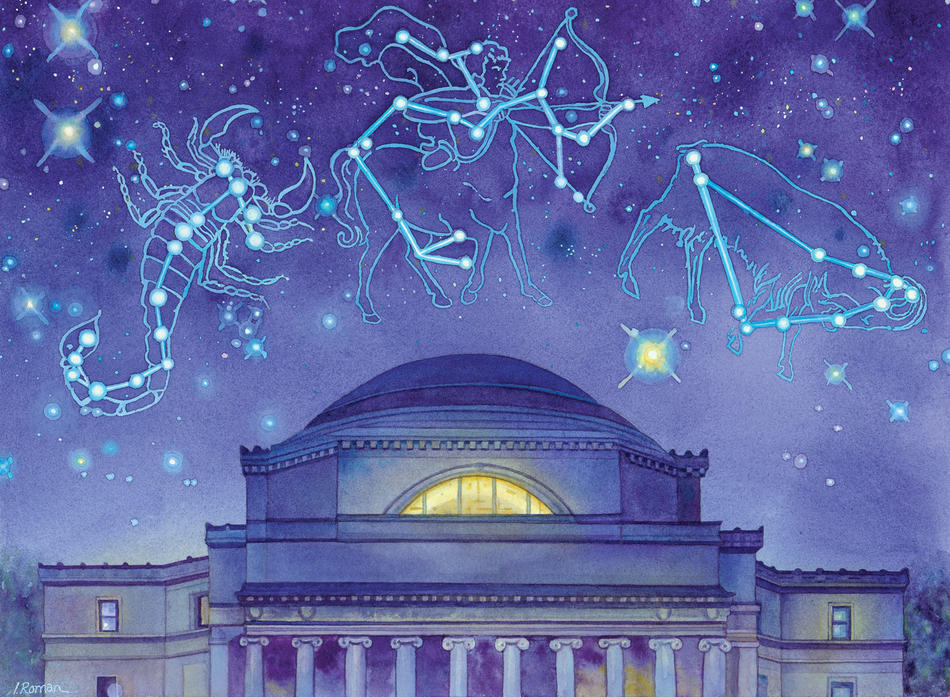If the path to enlightenment begins with the mapping of the stars, as the ancient astronomers taught, students standing in the vestibule of Low Library for the first time are well-positioned — although they might not notice it.
To be fair, one would expect a celestial representation to be displayed high up, perhaps on the ceiling. But in the atrium of Low, one must look downward to see the heavens. There, in the floor, encircling the fluted pedestal of Athena like a hammered belt of light, and partly obscured by rubber mats, lies a familiar-looking configuration: the signs of the zodiac, artfully rendered in eight panels in a marble mosaic.
To the modern observer, these brass bas-reliefs, worn flat by a century of foot traffic, might spark thoughts of The Secret Language of Birthdays or tabloid advice about whose letters to burn. But students entering the library on the first day of classes in early October 1897 knew just what the signs embodied. “The zodiac represents the cosmos,” says Barry Bergdoll, professor of architectural history at Columbia and the Philip Johnson Chief Curator of Architecture and Design at MoMA, “and the quest to encompass in a single building the sum total of knowledge.”
What the students would not likely have known — and what few know today — was how much attention had been devoted to bringing the zodiac to the library.
Seth Low himself, his wife Annie Curtis Low, the University’s Beaux-Arts architect Charles McKim, ironmaster John Williams, a marble worker named E. B. Tompkins, and members of a Special Committee all collaborated, by way of letters, meetings, resolutions, and votes, to situate the reliefs in the building.
What was really occurring was a relocation, because the signs had been created for McKim’s New York State Building at the 1893 Columbian Exposition in Chicago. They were cast by Williams, a Manhattan smithy whose shop was renowned for its hand-forged work, and one possible destination after the World’s Fair was McKim’s Boston Public Library. Instead, Williams helped steer them to the center of the newly named Columbia University.
In a September 1896 letter to Low, a very pleased McKim wrote that Williams and his friend Tompkins, “knowing my desire to secure this pavement for the Library,” had offered to donate, set, and present it gratis to the University. “The octagonal frame . . . as by a miracle, exactly fits the space between the steps of approach leading to the President’s room on one side and the Trustees on the other,” he wrote.
McKim’s interests extended much further than the line between these two rooms, according to Bergdoll. The architect’s expertise referred to the French academic tradition of the late 18th and 19th centuries and a history of thinking about ways to unify a processional axis with iconography of knowledge and the pursuit of knowledge.
“The zodiac is traditional in libraries in general and in Beaux-Arts libraries in particular,” Bergdoll says. “Low Library is the center of the campus universe, and the zodiac is in the center of the vestibule, as kind of prelude to the dome. You come into the building, walk over the zodiac — over the celestial sphere — through the marble columns, and are drawn to the light in the rotunda. The dome is painted blue. Originally there was hanging from the dome a glass sphere, and the dome was painted with stars. This celestial theme runs through the iconography of the building, enhanced for many years by the sundial placed on an axis with the library on the other side of 116th Street — College Walk — a link between the two halves of the campus.”
In the 1890s, visitors to Low would have grasped the reference. “Educated people understood what these things symbolized,” says Andrew Dolkart, the James Marston Fitch Professor of Historic Preservation at Columbia’s Graduate School of Architecture, Planning and Preservation. “People knew how to look. It was part of society. You were trained to be well versed in classical knowledge.”
In other words, nobody on “the Acropolis of America,” as Morningside Heights was known, had to explain the zodiac or point out that Athena was the goddess of wisdom.
Yet even though the zodiac circle and the bust of Athena signaled Low’s (or perhaps only McKim’s) allegiance to Periclean Athens, Columbia had recently abandoned Greek as an admission requirement. True, freshmen were still required to take Greek and Latin, and rhetoric was still a required course for freshmen, sophomores, and juniors, but the new way in pointed to a new way out — a different kind of literacy, epitomized by the expansion of the college into a university.
“Being versed in classicism is the old idea that a perfect education was a classical education,” Dolkart says. “We have a much broader notion of what education is today. We have a broader, more open view of what an educated individual is.”



